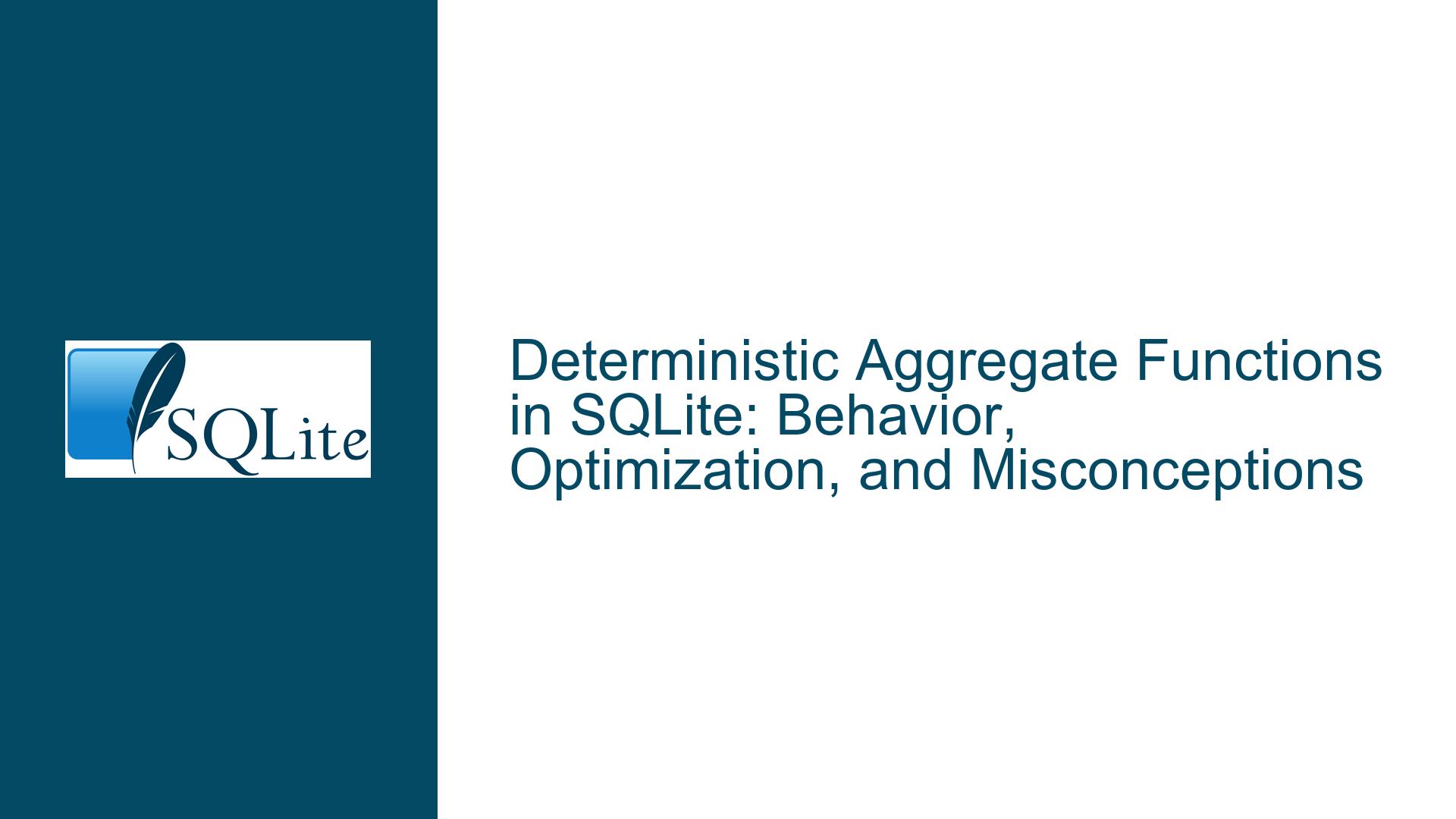Deterministic Aggregate Functions in SQLite: Behavior, Optimization, and Misconceptions
Core Principles of Deterministic Functions in SQLite
The concept of determinism in SQLite functions—whether scalar, aggregate, or window—is foundational to query optimization and result consistency. A deterministic function guarantees that for identical input values, it will always produce the same output. This property allows SQLite’s query planner to optimize execution by caching results or precomputing values during query compilation.
For scalar functions, the SQLITE_DETERMINISTIC flag is critical. When marked as deterministic, SQLite can evaluate the function once during compilation if its arguments are constant expressions, rather than recalculating it for every row. For example, SELECT LOWER('HELLO') FROM table will compute LOWER('HELLO') once, reuse the result across all rows, and avoid redundant computations.
However, aggregate functions (e.g., SUM(), COUNT(), user-defined aggregates) and window functions behave differently. Their execution depends on processing multiple rows of data to produce a result. The determinism of an aggregate function is not about whether it processes the same input rows identically (which it inherently does) but whether the aggregation logic itself introduces variability. For instance, an aggregate that computes a checksum using a random seed would be non-deterministic.
The confusion arises from the interplay between the SQLITE_DETERMINISTIC flag and how SQLite’s query optimizer treats aggregate functions. Unlike scalar functions, marking an aggregate as deterministic does not enable optimizations such as result caching or loop factorization. This is because aggregates must process all qualifying rows each time they are invoked; there is no scenario where their evaluation can be short-circuited or reused across queries.
Why the SQLITE_DETERMINISTIC Flag Has No Impact on Aggregate Functions
Execution Model of Aggregate Functions
Aggregate functions operate in two phases: accumulation (processing each row) and finalization (computing the result after all rows are processed). Even if an aggregate is deterministic, SQLite cannot skip the accumulation phase because the input dataset might change between queries. The query planner has no mechanism to cache intermediate aggregation states across different query executions.Absence of Optimization Opportunities
Scalar functions with constant arguments can be optimized because their inputs are fixed at query compile time. In contrast, aggregates inherently depend on runtime data. For example,SUM(column)varies based on the rows incolumn, even if the function itself is deterministic. TheSQLITE_DETERMINISTICflag does not provide the optimizer with additional information to bypass row processing.Window Functions and Statefulness
Window functions (e.g.,ROW_NUMBER(),RANK()) add further complexity. These functions rely on the order and partitioning of rows, which are dynamic properties determined at runtime. Marking a window function as deterministic would not eliminate the need to recompute rankings or row numbers for each query.Built-In Aggregates Are Deterministic by Default
SQLite’s built-in aggregate functions (e.g.,AVG(),MAX()) are deterministic because their outputs depend solely on their inputs. However, this determinism is hardcoded; theSQLITE_DETERMINISTICflag is irrelevant to their operation.
Best Practices for Defining and Debugging User-Defined Aggregates
Step 1: Clarify the Purpose of Determinism in Aggregates
When creating a user-defined aggregate function, the SQLITE_DETERMINISTIC flag should only be set if the aggregation logic is guaranteed to produce the same result for the same input dataset. For example:
- Deterministic aggregate: A custom
SUM_SQUARES()function that sums the squares of inputs. - Non-deterministic aggregate: A
RANDOM_MEAN()function that computes an average but incorporates a random perturbation.
Even though SQLite does not leverage this flag for optimizations, marking aggregates accurately improves code clarity and future-proofs your implementation.
Step 2: Validate Aggregate Logic for Hidden Non-Determinism
Non-determinism in aggregates can arise from:
- Reliance on external state (e.g., global variables, file input).
- Use of non-deterministic subroutines (e.g.,
random(),time()). - Floating-point operations with platform-specific rounding (rare, but possible).
Debugging tactic:
Isolate the aggregate function and test it against static datasets. Run the function multiple times on the same data and verify that outputs match. For example:
-- Create a test table with fixed data
CREATE TABLE test_data (x INTEGER);
INSERT INTO test_data VALUES (1), (2), (3);
-- Execute the aggregate multiple times
SELECT my_aggregate(x) FROM test_data; -- Should return the same value every time
Step 3: Compare Scalar vs. Aggregate Optimization Behavior
To observe how SQLITE_DETERMINISTIC affects scalar functions but not aggregates:
Scalar function example:
// A deterministic scalar function
void deterministic_add(sqlite3_context *ctx, int argc, sqlite3_value **argv) {
int a = sqlite3_value_int(argv[0]);
int b = sqlite3_value_int(argv[1]);
sqlite3_result_int(ctx, a + b);
}
// Register with SQLITE_DETERMINISTIC
sqlite3_create_function(db, "deterministic_add", 2, SQLITE_UTF8, 0, deterministic_add, 0, 0);
In a query like SELECT deterministic_add(5, 10) FROM large_table, SQLite computes 15 once and reuses it for all rows.
Aggregate function example:
// A deterministic aggregate
typedef struct {
int sum;
} MySumCtx;
void mysum_step(sqlite3_context *ctx, int argc, sqlite3_value **argv) {
MySumCtx *p = (MySumCtx*)sqlite3_aggregate_context(ctx, sizeof(*p));
p->sum += sqlite3_value_int(argv[0]);
}
void mysum_final(sqlite3_context *ctx) {
MySumCtx *p = (MySumCtx*)sqlite3_aggregate_context(ctx, 0);
sqlite3_result_int(ctx, p->sum);
}
// Register with/without SQLITE_DETERMINISTIC
sqlite3_create_function_v2(db, "mysum", 1, SQLITE_UTF8 | SQLITE_DETERMINISTIC, 0, 0, mysum_step, mysum_final);
Regardless of the SQLITE_DETERMINISTIC flag, SELECT mysum(x) FROM large_table will process every row of large_table each time the query runs.
Step 4: Use EXPLAIN to Analyze Query Plans
SQLite’s EXPLAIN command reveals whether optimizations like constant folding or loop factorization are applied. For scalar functions, marking them as deterministic simplifies the bytecode:
EXPLAIN SELECT deterministic_add(5, 10) FROM large_table;
-- Shows a single "Result" opcode instead of repeated function calls
For aggregates, the bytecode will always include AggStep and AggFinal opcodes, regardless of determinism.
Step 5: Future-Proofing and Documentation
While current SQLite versions (as of 3.41.0) ignore the SQLITE_DETERMINISTIC flag for aggregates, future optimizations might leverage it. For example:
- If SQLite introduces materialized views that auto-refresh only when underlying data changes, deterministic aggregates could be cached.
- Query planners might skip re-aggregation if the dataset and function are both deterministic.
Recommendation: Always mark aggregates as deterministic if they meet the criteria, even though it currently has no effect.
Common Pitfalls and Fixes
Pitfall 1: Assuming that deterministic aggregates improve performance.
Fix: Focus optimization efforts on indexing, query structure, or scalar functions.
Pitfall 2: Misdiagnosing non-determinism in complex aggregates.
Fix: Use SQLite’s sqlite3_test_control(SQLITE_TESTCTRL_ISINIT) and deterministic checkpoints to isolate external state.
Pitfall 3: Overlooking window function dependencies.
Fix: Treat window functions as inherently non-deterministic if their partition or order clauses depend on volatile expressions.
By understanding the role of determinism in SQLite’s function execution model, developers can avoid misconfigurations and write more efficient, reliable queries. While the SQLITE_DETERMINISTIC flag is a no-op for aggregates today, adhering to best practices ensures compatibility and clarity in your codebase.






